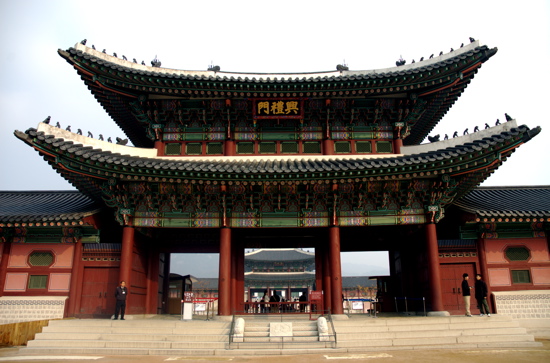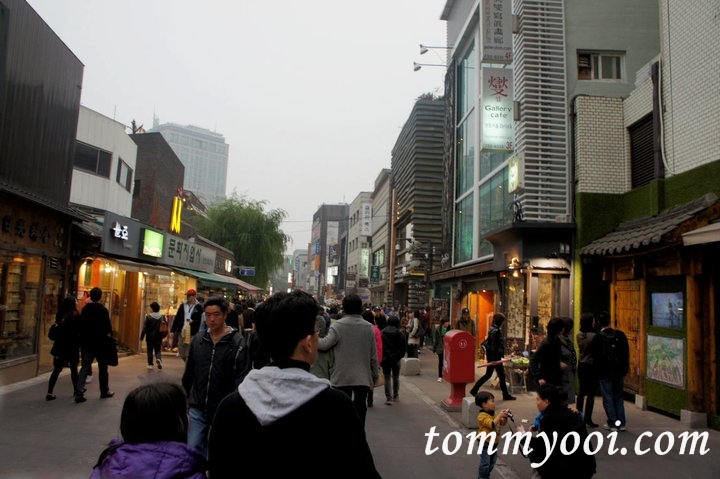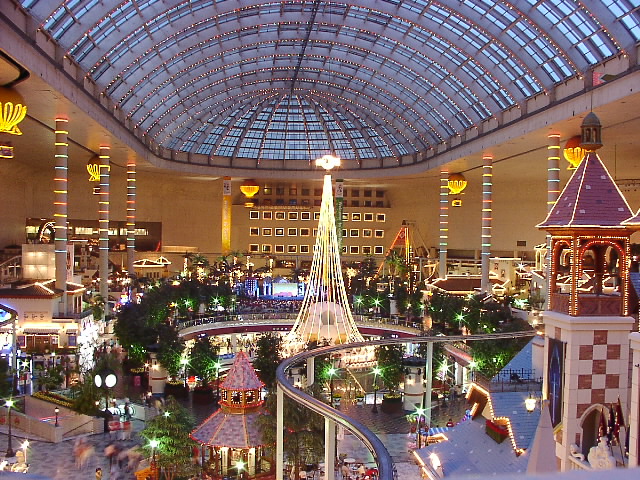
Comprehensive Seoul Travel Guide – 15 Must Visit Seoul Attractions by TommyOoi.com. Check out Sightseeing Places to visit in Seoul.
1. Gyeongbokgung

Gyeongbokgung Palace arguably the most beautiful and remains the grandest of all five palaces is also called “Northern Palace” because it is the furthest north when compared to the neighboring palaces of Changdeokgung (Eastern Palace) and Gyeongheegung (Western Palace).
The name of the palace, Gyeongbokgung, translates in English as “Palace of Shining Happiness.” The premises were destroyed by fire at the time of Japanese occupation from 1592-1598. However, all of the palace’s 7,700 rooms were later restored under the leadership of Heungseondaewongun during the reign of King Gojong.
The National Palace Museum of Korea is located south of Heungnyemun Gate, and the National Folk Museum is located east within Hyangwonjeong.
Admission Fees
Adults (ages 19-64) 3,000 won / Group 2,400 won (10 or more people)
Youths (ages 7-18) 1,500 won / Group 1,200 won (10 or more people)
Age 6 and under – FREE.
Youths (ages 7-18) 1,500 won / Group 1,200 won (10 or more people)
Age 6 and under – FREE.
Opening Hours
March to October 09:00-18:00 / November to February 09:00-17:00.
Closed on Tuesday
Getting there
By Subway
Exit 5 – Gyeongbokgung Station Line 3
2. Myeongdong

It is all about fashion, fashion & fashion in Myeongdong, Seoul’s primary & most famous shopping district. If it’s variety that you’re after, there’s no better place to shop than Myeong-dong where you’ll find everything from internationally-recognized name brands to unique items.
Myeongdong also houses a variety of family restaurants, fast food, plus Korean, Western and Japanese dining options. Many restaurants in Myeongdong specialize in pork cutlet (donkas) and kalguksu (thick noodles).
Not to forget, Myeongdong is the place where everyone shops for famous Korean Cosmetic brands such as Etude House, Skin Food, Laneige, The Face Shop, Missha!
Opening Hours
10am to 10pm everyday
Getting there
By Subway
Exit 5, 6, 7, or 8 – Myeongdong Station Line 4
Read My Blog Post : Myeongdong
3. N Seoul Tower

N Seoul Tower located on Mt. Namsan offers great panoramic views of the city, and has been a symbol of Seoul since it first opened to the public in 1980.
Not only the tower was recently undergone a major remodeling, but also a new name following a complete makeover. It is now a true cultural space with various performances, movies, exhibitions as well as upscale restaurants and snack bars.
Admission Fees
Opening Hours
Sunday-Thursday
Observatory: 10:00-23:00
Restaurant: 11:00-23:00
Teddy Bear Museum: 10:00-22:00 (Last entry: 21:00)
Observatory: 10:00-23:00
Restaurant: 11:00-23:00
Teddy Bear Museum: 10:00-22:00 (Last entry: 21:00)
Friday-Saturday
Observatory: 10:00-24:00
Restaurants (n.GRILL/Hancook): 11:00-23:00
The place dining: 11:00-24:00 (Last seating: 23:00)
Teddy Bear Museum: 10:00-22:00
Observatory: 10:00-24:00
Restaurants (n.GRILL/Hancook): 11:00-23:00
The place dining: 11:00-24:00 (Last seating: 23:00)
Teddy Bear Museum: 10:00-22:00
Getting there
By Subway & Bus
Exit 2 – Chungmuro Station Line 3 or 4. Then take Bus 2 (08:00-24:00/5min intervals) or Bus 5 (07:30-23:50/15min intervals) to N Seoul Tower.
Exit 4 – Itaewon Station Line 6. Then take Bus 3 (08:00-23:00/10min intervals) to N Seoul Tower.
By Subway & Cable Car
Exit 3 – Myeongdong Station Line 4. Take the wide road next to 7 Eleven convenience store, then walk straight to the left of Pacific Hotel & keep walking up in the direction of Mt. Namsan where the cable car platform is situated.
Fare: Round-trip – 6,300 won / One-way – 4,800 won
Cable Car Opening Hours: 10:00~22:30
4. Dongdaemun

Dongdaemun is Korea’s largest wholesale and retail shopping district has 26 shopping malls, 30,000 specialty shops, and 50,000 manufacturers. Opening from 10:30 a.m. to 5:00 a.m. except Monday & some public holidays, you can literally shop all night !!
The fabric and clothing here are of the latest fashion trends in the world. Inventory is imported and exported in real time, making Dongdaemun a must-visit for fashion enthusiastic.
Opening Hours
Tuesday to Saturday – 10.30am to 5.00am
Sunday – 10.30am to 11.00pm
Closed on Monday & some public holidays.
Getting there
By Subway
Exit 8 or 9 – Dongdaemun Station Line 1 or Line 4
5. Cheong Wa Dae

Cheongwadae is the executive office and official residence of the President of the Republic of Korea. The Korean name literally translates to “pavilion of blue tiles.”
The signature markings of the Presidential Residence of Cheong Wa Dae are its blue tiles. It is the first thing that catched one’s attention upon entering the premises. The blue tiles and the smooth roof blend beautifully with Mt. Bugaksan in the backdrop.
The unique buildings Cheong Wa Dae are comprised of the Main Office, Yeongbingwan (Guest House), Chunchugwan (Spring and Autumn Pavilion), Nokjiwon (Green grass), the Mugunghwa (Rose of Sharon) Valley, and the Seven Palaces.
There is also a weekly Military Drill Demonstration & Parade by the honor guards every Saturday 10am.
Opening Hours
Tours start at 10:00, 11:00, 14:00, and 15:00
Summer season (Jul. 1-Sep. 16): 10:00, 11:00, 15:00, 16:00
Closed on Sunday, Monday & Holidays.
** Reservation must be made by email minimum 10 days earlier. Please bring your Passport & ID card. Time may change, please check the official website.
More info of the tour : Cheong Wa Dae Official Site
Getting there
By Subway
Exit 5 – Gyeongbokgung Palace Station Line 3. Walk 10 minutes.
6. Bukchon Hanok Village

Situated between by two palaces, Gyeongbokgung to the west and Changdeokgung to the east, this village has the largest cluster of privately owned traditional Korean wooden homes or hanok in Seoul.
The Bukchon area is a traditional residential area in Seoul that boasts 600 years of history. Its location reflects the views of neo-Confucianism, regarding the world and nature, during the Joseon Dynasty.
Hanok architecture places great emphasis on the topographical features of the land on which it is built. Structural arrangements, layouts, and other spatial aesthetics are major concerns here, as are the styles of the buildings themselves.
Opening Hours for Bukchon Traditional Culture Center
Mon~Fri (9:00 ~ 18:00)
Sat~Sun (9:00 ~ 17:00)
Sat~Sun (9:00 ~ 17:00)
Getting there
By Subway
Exit 2 – Anguk Station Line 3. Walk straight for about 300m.
7. Changdeokgung
Changdeokgung Palace was the second royal villa built following the construction of Gyeongbukgung Palace in 1405. The buildings have remained largely intact over six centuries and served as a backdrop for the last chapters of the Joseon period (1392-1910).
Korea’s last emperor Sunjong passed away on these grounds in 1926, and it’s commonly known that members of royal descendants lived in Nakseonjae, a cluster of unpainted palace buildings well into the late ‘80s.
The palace had a great influence on the development of Korean architecture, garden and landscape planning, and related arts, for many centuries. It reflects sophisticated architectural values, harmonized with beautiful surroundings.
Admission Fees
Regular Tour (Changdeokgung Palace)
Individuals: Adults (ages 19-64) 3,000 won/Children (ages 7-18) 1,500 won
Groups (10 or more people): Adults 2,400 won/Children 1,200 won
Huwon Tour (Secret Garden area)
Adults (ages 19 and over) 5,000 won/Children (ages 7-18) 2,500 won
Opening Hours for Bukchon Traditional Culture Center
Regular Tour (Changdeokgung Palace)
April–October: 09:00-18:30 / March & November: 09:00-17:30 / December–February: 09:00-17:00
Huwon Course (Guided Tour only)
April–October: 09:00-16:30 / March & November: 09:00-15:30 / December–February: 09:00-15:00
Getting there
By Subway
Exit 3 – Anguk Station Line 3. Walk straight for 5min.
OR
Exit 7 – Jongno 3(sam)-ga Station Line 1, 3 or 5. Go straight along Donhwamun-ro Street for 10min.
Read My Blog Post : Changdeokgong
8. Insadong

One of the most memorable Seoul attractions and represents the focal point of Korean traditional culture and crafts. Stores in Insa-dong specialize in a wide variety of goods that can only be purchased or appreciated in Korea: hanbok (traditional clothing), hanji (traditional paper), traditional teas, pottery, and folk crafts.
There are about 100 galleries in the area and you can see every example of traditional Korean fine art from paintings to sculptures. The teahouses and restaurants are the perfect compliment to the galleries.
Every Sunday from 10:00 – 22:00, some streets are blocked off from traffic and it becomes a cultural space. Stores set up booths outside and others set up shop (Korean candy merchants and fortune tellers.) There are traditional performances and exhibits as well.
Getting there
By Subway
Exit 6 – Anguk Station Line 3. Walk straight 100m & turn left.
Exit 3 – Jonggak Station Line 1. Walk 300m straight, turn left. then 100m straight & veer left into Insa-dong alleyway.
Read My Blog Post : Insadong
9. Hongdae

The area surrounding Hongdae as it’s affectionately called, is the center of Korea’s youthful nightlife. Many of Seoul’s idiosyncratic clubs that draw the younger set are clustered in the area.
With Hongik University nearby, a prestigious school known for its leading arts and design programs, the area attracts students and visitors alike to shop & club. The highest concentration of clothing stalls and vintage shops can be found along the main passageway, Eo Ulmadang-gil, minutes away from the subway station.

And if you are a Hello Kitty Fan, there is more reasons for you to enjoy Hongdae as there is a Hello Kitty Cafe nearby the subway station where you can sip Hello Kitty Latte & indulge in Hello Kitty cakes & pastry. Definitely a must visit for Hello Kitty fans !!
For more Hello Kitty Cafe photos : Hello Kitty Cafe
Opening Hours
Every evening till late night
Getting there
By Subway
Exit 6 – Hongik Univ. Station Line 2
Read My Blog Post : Hello Kity Cafe Seoul
10. Itaewon

Itaewon is choc-a-block with trendy bars, clubs, restaurants and shops selling everything from reproduction Korean furniture and tailored suits to jewelry and Korean pottery.
Seoul even designated Itaewon as its first ‘Special Tourism District,’ to highlight it as a destination for internationals to enjoy a diversity of culture, shopping, and entertainment experiences.
Every foreigner who comes to Seoul gravitates to this gritty expat-friendly neighborhood near the main U.S. Army base.
Opening Hours
Daily 10am to late at night
Getting there
By Subway
Exit 1 – Itaewon Station Line 6
11. Jongmyo Shrine

Jongmyo is the term used for a place where memorial services are performed for deceased kings, and Sajik is the term for a place where services for the Gods of Earth and Crops are performed.
The Shrine is the oldest and most authentic of the Confucian royal shrines to have been preserved. Dedicated to the forefathers of the Joseon dynasty (1392–1910), the shrine has existed in its present form since the 16th century and houses tablets bearing the teachings of members of the former royal family.
Ritual ceremonies linking music, song and dance still take place there, perpetuating a tradition that goes back to the 14th century. It enshrines the memorial tablets of greatly honored kings and their queens, today containing 19 memorial tablets of kings and 30 tablets of their queens in 19 spirit chambers.
Admission Fees
Adults (ages 19 and over): KRW 1,000
Youths (ages 7-18): KRW 500
No group discounts. Free admission for children (ages 6 and under)
Opening Hours
Guided Tours
Korean – 9 times a day / 09:20 – 16:20 (every hour), 17:00 (Mar. to Sep. only)
English – 10:00, 12:00, 14:00, 16:00
Japanese – 09:00, 09:40, 10:40, 11:40, 12:40, 13:40, 14:40, 15:40, 16:40 (Mar. to Sep. only)
Chinese – 11:00, 15:00
Getting there
By Subway
Exit 11 – Jongno 3 (sam)-ga Station Line 1.Walk for 7 mins from station.
Exit 8 – Jongno 3 (sam)-ga Station Line 3 or 5. Walk for 7 mins from station.
12. Namiseom Island ( Winter Sonata )
For Korean Drama lovers, Nami Island is a place which does not requires further introduction as this is the birth place of all the Korean Craze. This is one of the place where the famous international Korean Drama Winter Sonata was filmed. Hence to put it short, it is a must visit for all Asian tourists!
Namiseom Island was formed as a result of the construction of the Cheongpyeong Dam. It is a half moon shaped (462,809㎡) isle, and on it is the grave of General Nami, who led a great victory against the rebels in the 13th year of the 7th king of the Joseon Dynasty, King Sejo (reign 1455 ~ 1468).
Admission Fees
Adults : 8,000 won
Children (ages 3-13) : 4,000 won
Visitors coming after 18:00 (Dec – Mar), after 19:00 (Apr – Nov) : 4,000 won
※ Round-trip ferry fare & tax included
Opening Hours
Daily 7:30am to 9:30pm
Getting there
By Subway + Train + Taxi
Exit Sangbong Station Line 7. Transfer to Gyeongchun Line Train to Gapyeong Station. Take a taxi to Gapyeong Wharf (Just say Nami Island to Driver will do. Taxi cost KRW3,000 to KRW4,000 per way)
For More Info : Namiseom Official Website
13. Everland

Operated by Samsung Group, Everland is South Korea’s largest theme park at 100 hectares. With 8.6 million visitors, it is ranked as the 4th most visited theme park in the world by offering 5 main Festivals and exciting entertainments all year around.
The park is home to over 40 heart-pounding rides and attractions. In addition to ‘Safari World’ featuring white tigers, tigers, lions and bears, ‘Herbivore Safari’ opened in April 2010, letting visitors get up close and personal with the safari’s giraffes, elephants, and ostriches.
Everland is also known for its gorgeous flower arrangements and beautiful gardens, which have been year-round fixtures since the Rose Festival in 1985.
Admission Fees
Opening Hours
Sunday to Friday – 10am to 6pm
Saturday & Public Holidays – 10am to 7pm
Getting there
By Subway & Bus
1. Exit 10 – Gangnam Station Line 2. Take bus 5002 to Everland. (Travel time: 50 min)
2. Exit 1 – Gangbyeon Station Line 2. Take bus 5800 to Everland. (Travel time: 50min)
3. Exit 2 or 3 – Sadang Station Lines 2 & 4. Take bus 1500-2 to Everland. (Travel time: 80 min)
For More Info : Everland Official Website
14. Lotte World

Lotte World consists of the world’s largest indoor theme park (a Guinness World Record) which is open all year around, an outdoor amusement park called “Magic Island”, an artificial island inside a lake linked by monorail, shopping malls, a luxury hotel, a Korean folk museum, sports facilities, and movie theaters all in one place.
Opened on July 12, 1989, Lotte World a major theme park complex in Seoul, South Korea, receives over 8 million visitors each year and is considered along with Tokyo Disney Resort as one of the world-class theme parks in Asia.
One of the major reasons tourists are attracted to Lotte World is the amusement rides. The Gyro Drop and Gyro Swing are the top pleasers– a steep drop with an altitude of 70 meters, or taste the thrilling sensation of being inside a tornado.
The Flume Ride is a long boat with a high-altitude wave, and the Spanish Pirate Ship swings at an electrifying 75 degrees. Besides the excitement of these rides, Lotte World also contains a variety of parades and laser shows.
Admission Fees
Opening Hours
Getting there
By Subway
For More Info : Lotte World Official Website
15. Seoraksan (Mount Seorak)
Seoraksan is the highest mountain in the Taebaek mountain range in the Gangwon province in eastern South Korea. It is located in a national park near the city of Sokcho. After the Hallasan volcano on Jeju Island and Jirisan in the south, Seoraksan is the third highest mountain in South Korea.
The Daechongbong Peak of Seoraksan reaches 1,708 metres (5,603 feet). The Taebaek mountain chain is often considered the backbone of the Korean peninsula.
Admission Fees
Free for the National Park
Camping (peak season /off season)
Adults (ages 19 and over) – 2,000 won / 1,600 won
Youth (ages 13- 18) – 1,500 won / 1,200 won
Children (ages under 13) – 1,000 won /800 won
Adults (ages 19 and over) – 2,000 won / 1,600 won
Youth (ages 13- 18) – 1,500 won / 1,200 won
Children (ages under 13) – 1,000 won /800 won
Auto camping (peak season /off season)
Small cars – 11,000 won / 9,000 won
Large cars – 17,000 won / 14,000 won
Small cars – 11,000 won / 9,000 won
Large cars – 17,000 won / 14,000 won
Getting there
By Bus
1. Take intercity bus from Dong Seoul Bus Terminal (Gangbyeon Station Line 2) to Sokcho every 30 minutes.From Sokcho or Sokcho Express Bus Terminal, take city bus No. 7 or 7-1 and get off at the entrance of Mt. Seoraksan (30 minute ride).
2. From Sokcho Intercity Bus Terminal, taxi takes 15-20 minute to the entrance of Mt. Seoraksan.








No comments:
Post a Comment